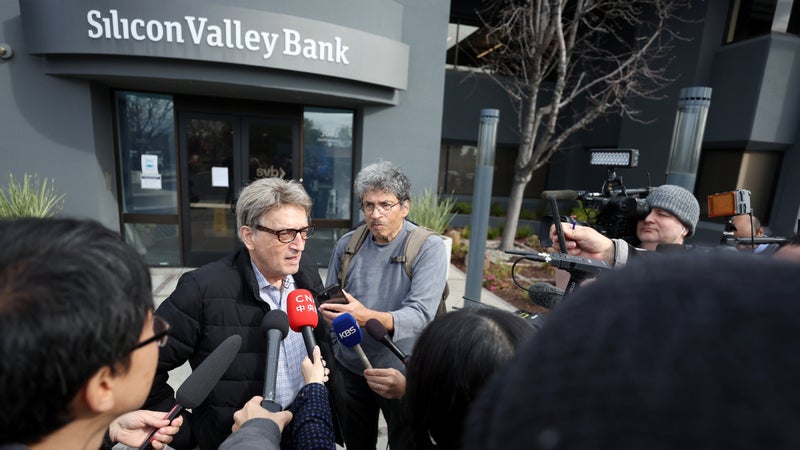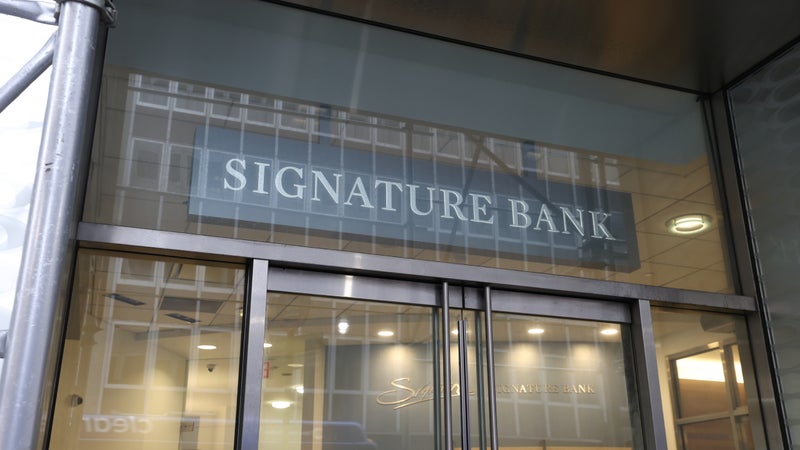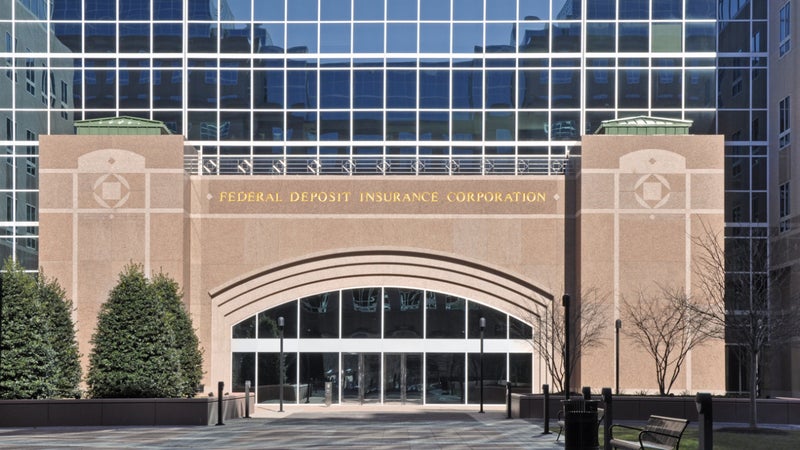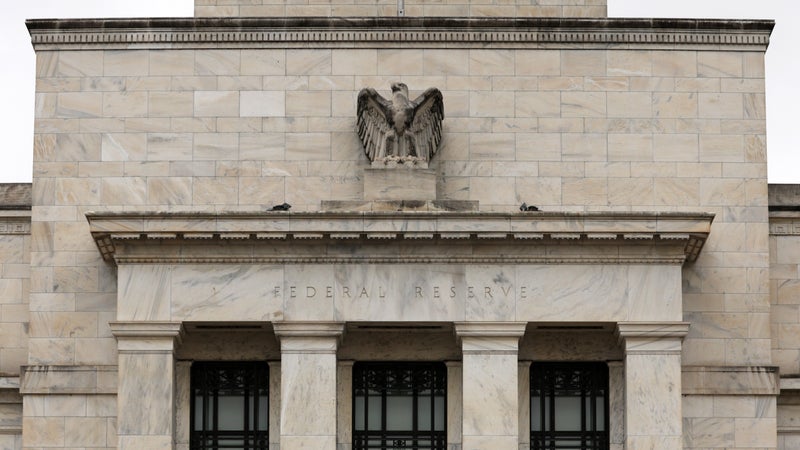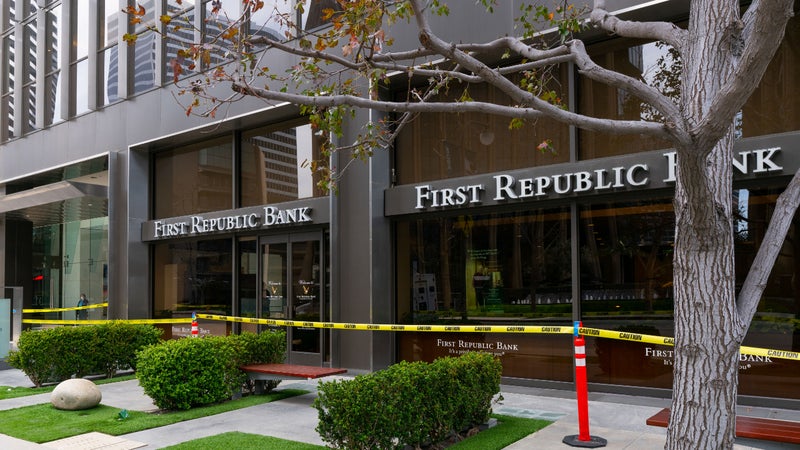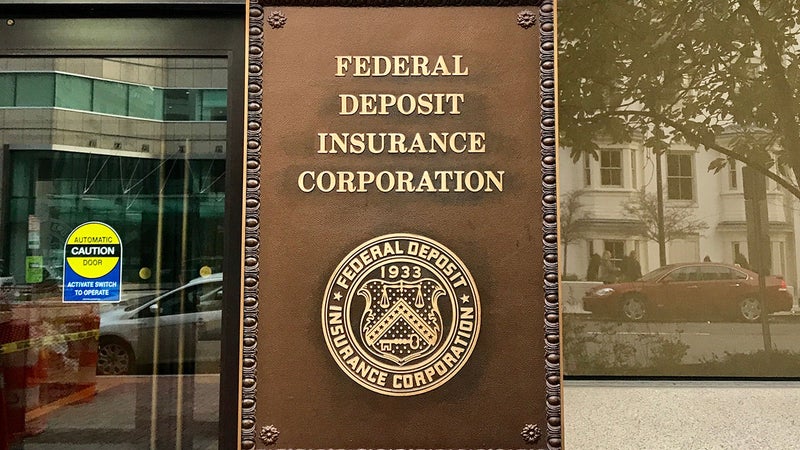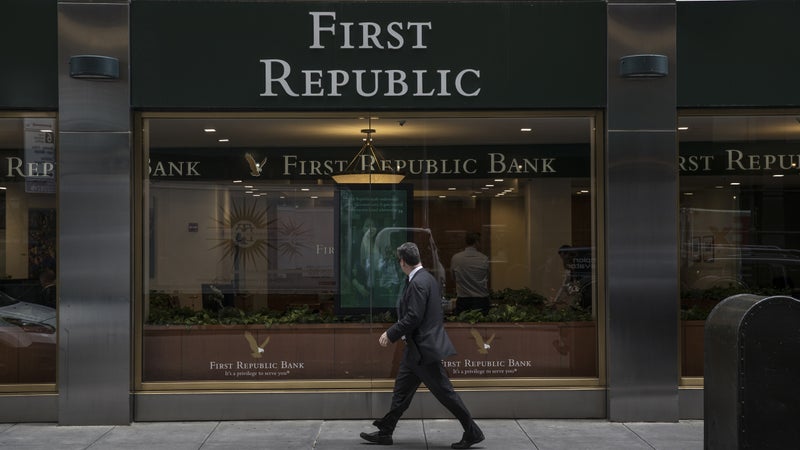2023 banking crisis: First Republic Bank’s failure; Silicon Valley Bank’s collapse and a timeline of the financial fallout that followed

The Bankrate promise
At Bankrate we strive to help you make smarter financial decisions. While we adhere to strict , this post may contain references to products from our partners. Here's an explanation for .
Throughout March, the banking system was shaken up by a number of high-profile bank failures, a volatile stock market and global banking concerns over the past few weeks. The catalyst was the abrupt closure of Silicon Valley Bank (SVB), the first FDIC-insured bank to fail in two years.
SVB was previously one of the largest banks serving the tech startup industry — and the 16th largest bank in the U.S. overall. After the bank was forced to sell bonds at a loss, its stock price plummeted and depositors panicked, leading to a classic bank run. This was the second-largest bank failure in U.S. history. The third-largest came just days later when Signature Bank ceased operations.
The FDIC took control of the bank’s branches and deposits before First Citizens acquired SVB. And as this played out, New York Community Bankcorp acquired a significant portion of Signature Bank’s assets.
The failure of these banks caused widespread panic, especially at regional banks where institutional customers had large amounts of uninsured deposits. Banking stocks were volatile, and there were concerns that other banks, such as First Republic Bank, might not be able to endure the turmoil. Ultimately, it did not. On Monday, May 1, First Republic Bank became the third bank to fail this year. JPMorgan Chase will buy most of the troubled bank’s assets.
Federal agencies — including the U.S. Treasury, the Federal Reserve and the FDIC — worked throughout March to contain the damage and sell off the troubled banks’ assets. Eventually, fears subsided as deposit outflows stabilized, seemingly marking an end to the latest banking crisis. But First Republic’s failure has reignited concerns over the health of the banking system, particularly for regional banks.
Here’s a look at the current situation with First Republic Bank’s failure, followed by a timeline of March’s bank failures and a roundup of the most significant news as the situation unfolded.
First Republic Bank’s failure — May 1
First Republic Bank has failed despite efforts of the U.S. government and private banks to keep it afloat. JPMorgan Chase bought most of the troubled bank’s assets and, on Monday, JPMorgan Chase is reopening First Republic’s 84 offices across eight states under its banner. All First Republic depositors will now become customers of JPMorgan Chase. JPMorgan will also acquire $173 billion of loans and $30 billion of securities from First Republic.
The bank, which had been struggling to make up for losses in recent months, ultimately succumbed to the market and was unable to make any deals to preserve it. In mid-March, 11 U.S. banks came together to provide First Republic with $30 billion in liquidity to prevent its collapse. However, the bank’s troubles persisted in the weeks that followed.
First Republic Bank had been in serious danger of collapsing ever since Silicon Valley Bank’s failure earlier in the year, experiencing outflows of over $100 billion in deposits, according to its first quarter balance sheet. On Friday, April 28, the bank’s stock closed down over 40 percent.
The FDIC determined that First Republic Bank could not be rescued, and it was put into receivership by the regulator. JPMorgan Chase subsequently submitted a bid, which was accepted, for all of First Republic Bank’s deposits.
The FDIC estimates that the failure will cost its Deposit Insurance Fund approximately $13 billion.
A timeline of March’s bank failure fallout
Silicon Valley Bank collapses after over two years without a bank failure — March 10
Silicon Valley Bank (SVB) is the first bank to fail since late 2020. Some of the major companies that had funds in SVB — and that have been affected by the bank’s collapse — include Vox Media, Roku, Etsy and Roblox.
News of the bank’s collapse came all at once, but there were a number of forces brewing that led up to its demise.
Over the past year, the Federal Reserve has hiked interest rates to combat high inflation. Increased rates mean higher borrowing costs, which puts a strain on companies, especially venture-backed startups that need funds — and venture-backed startups were some of SVB’s main customers. At the same time, increased interest rates reduced the value of the bonds in which banks like SVB invested their customers’ deposits when rates were lower.
On March 8, two days before the collapse, SVB sold a $21 billion bond portfolio at a $1.8 billion loss. The bank also announced it would sell $2.25 billion of common equity and depository shares to compensate for its customers’ withdrawals, but the bank was unable to complete this equity offering before being shuttered. By the end of March 9, the bank’s stock fell 60 percent to a drastic loss of over $80 billion in bank shares.
This sent depositors rushing to withdraw their funds.
Signature Bank becomes third-largest bank to fail — March 12
Signature Bank, a New York-based commercial bank, was closed by New York regulators, citing the bank as a systemic risk to the financial system’s stability. Signature Bank is the third-largest bank failure in U.S. history, with SVB coming in second and Washington Mutual, which failed in 2008, coming in first.
Signature Bank’s sudden closure is at least partly due to SVB’s collapse. The New York-based bank was previously one of the main banks in the cryptocurrency industry, which was already reeling from the liquidation of Silvergate, previously the largest crypto bank.
With the crypto market already fumbling and investors withdrawing funds ever since the collapse of FTX in late 2022, SVB’s closure incited a bank run at Signature Bank, which had a significant amount of large, uninsured deposits. This prompted regulators to intervene, attempting to stave off a larger financial meltdown.
Signature Bank depositors are receiving the same treatment as SVB depositors: The FDIC said it will attempt to make all depositors whole, regardless of whether their funds were all insured or not.
Government launches investigation of Silicon Valley Bank failure — March 14
On March 13, the FDIC announced it transferred all insured and uninsured deposits to Silicon Valley Bridge Bank, N.A., a newly created bridge bank. It reported customers can access their funds through debit cards, ATMs and check writing in the same manner as before.
The Fed released a statement ensuring that no taxpayers will face any losses from the bank’s closure. While depositors are protected, the Fed states that “shareholders and certain unsecured debtholders will not be protected.”
Following the collapse of SVB, both the U.S. Department of Justice and the Securities and Exchange Commission are conducting separate investigations into the failure and stock sales made by the bank’s financial officers the day before, according to a report from the Wall Street Journal.
The report notes that the investigations may not lead to any charges and are not unusual following a big loss.
One of the focuses of the investigation is the large sale of stocks that came before the bank’s collapse. SVB’s Chief Executive Officer Greg Becker sold $3.6 million of company stock just under two weeks before the failure, Bloomberg reports. This was one of several insider sales since the start of 2023.
Moody’s downgrades banking system to negative — March 14
Moody’s Investors Service, a leading global provider of credit ratings, changed its outlook on the U.S. banking system from stable to negative, citing a “rapidly deteriorating operating environment.” The cut in outlook comes in the wake of the SVB and Signature collapses.
Moody’s has also placed six other banks under review for a downgrade: First Republic Bank, Western Alliance Bancorp, Comerica Inc., Intrust Financial Corporation, UMB Financial Corp and Zions Bancorporation. These banks are among those seeing the sharpest decline in their stock price.
Most of these banks are regional banks that’ve been facing increased pressure following the collapses of SVB and Signature, as they raise much of the same liquidity concerns that led to SVB’s demise.
As a result, the credit ratings firm’s report outlined that banks with “substantial” amounts of Treasury bonds (which have lost their value from the Fed’s rate hikes) and uninsured deposits will be among those facing the most pressure.
Warren and Porter unveil bill to strengthen bank regulations — March 14
Led by Sen. Elizabeth Warren and Rep. Katie Porter, a group of Democrats have proposed legislation that would repeal part of a Trump-era law that eased bank regulations, NBC first reported.
This move from the Democrats comes a day after President Joe Biden’s speech addressing the SVB and Signature Bank failures, in which he called for Congress to bolster regulations of banks.
The proposed Warren-Porter bill would restore part of the Dodd-Frank Act created after the 2008 financial crisis, which was rolled back under the Trump administration.
Banking crisis reaches Europe as Credit Suisse shares plummet — March 15
Credit Suisse, a global investment bank based in Switzerland, lost about 25 percent of its share value. Trading of the bank’s shares was automatically paused on the Swiss market as a result.
Meanwhile, the Saudi National Bank — Credit Suisse’s top shareholder — has ruled out the possibility of providing further investments. The Saudi bank’s chairman told Reuters that its stake in the Swiss bank cannot go above 10 percent due to regulations.
Other European banks have seen stocks drop, too. UBS Group AG, a rival Swiss bank, fell more than 10 percent, as did France’s Societe Generale SA, and Germany’s Deutsche Bank was down about 8 percent Wednesday morning.
American banks and financial services companies aren’t fairing too much better. Morgan Stanley, and Citigroup have both fallen more than 5 percent as of this writing, and Wells Fargo has fallen more than 9 percent.
As Europe begins to reel from SVB and Signature’s collapse, U.S. markets continue tumbling. The Dow and S&P 500 were down by approximately 0.9 and 0.7 percent, respectively, when the market closed on Wednesday. The Nasdaq Composite saw a minor lift, however, with a 0.05 percent gain.
First Republic Bank losses persist, Credit Suisse gets lifeline — March 16
Since the SVB failure, First Republic Bank has stood out as one of the more prominent regional banks that could face a crisis as well. As of this writing, the bank’s stock is down over 30 percent. The bank is also still being reviewed by Moody’s for a downgrade.
There is talk that First Republic Bank is considering a sale to stave off the worst possible outcome, according to a report from Bloomberg late March 15.
Meanwhile, Credit Suisse has responded promptly to its losses from yesterday by borrowing over $50 billion from the Swiss National Bank. The Swiss global investment bank also announced it would repurchase certain debt securities for cash of up to about $3 billion. These moves are intended to help the bank maintain adequate liquidity and allay fears of a banking crisis across the European market. Following this announcement, Credit Suisse’s stock has been trending upward.
Treasury Secretary Yellen reassures Congress the U.S. banking system “remains sound” — March 16
Treasury Secretary Janet Yellen testified before the Senate Finance Committee Thursday morning, seeking to soothe consumer and Congressional fears about the current state of the nation’s financial system.
“I can reassure the members of the Committee that our banking system remains sound,” Yellen said at Thursday’s hearing, “and that Americans can feel confident that their deposits will be there when they need them.”
Yellen reemphasized the federal government’s commitment to containing the damage from SVB’s and Signature’s failures, touting the Treasury’s work with the FDIC and the Federal Reserve to ensure that depositors were paid back — and they were, according to Yellen.
Depositors had access to their funds Monday morning, “so they could make payroll and pay the bills,” Yellen said, highlighting that taxpayer money wouldn’t be used in paying back depositors. Moreover, Yellen repeated the federal government’s position that investors are not being protected from the collapses of SVB and Signature Bank.
The Treasury Secretary also defended federal regulators’ actions over the past week, saying that the moves were not about nationalizing the banking system but to avert contagion that could come from the collapse of large banks “that would place community banks across the country at risk of runs.”
Largest U.S. banks join forces to save First Republic Bank — March 16
Eleven U.S. banks came together to bail out First Republic, depositing $30 billion into the bank to keep it afloat, according to a joint statement from the U.S. Treasury, Federal Reserve, FDIC and the Office of the Comptroller of the Currency.
The banks coalescing are some of the largest in the U.S., including JPMorgan Chase, Citigroup, Bank of America and Wells Fargo, according to a report from Reuters.
First Republic Bank faced mounting pressure all week and has been in serious danger of collapsing in the wake of SVB’s failure. Its solvency was threatened as depositors started withdrawing their funds in the wake of the recent bank failures and the bank saw its credit ratings drop, which would make it that much more expensive to raise more funds.
“This show of support by a group of large banks is most welcome, and demonstrates the resilience of the banking system,” the joint statement said.
SVB Financial files for bankruptcy, Biden calls for accountability — March 17
Silicon Valley Bank Financial Group, parent company of collapsed Silicon Valley Bank, filed for Chapter 11 bankruptcy, kickstarting a court-led process to liquidate its assets and pay creditors back.
SVB Financial Group said Friday it has approximately $2.2 billion of liquidity and $3.3 billion in unsecured debt.
The filing doesn’t include SVB Capital or SVB securities — its venture capital firm and broker-dealer business, respectively — as these are separate legal entities from SVB Financial Group. Both entities will remain operational. Moreover, the filing doesn’t include Silicon Valley Bank or the bank’s successor created by the FDIC.
“The Chapter 11 process will allow SVB Financial Group to preserve value as it evaluates strategic alternatives for its prized businesses and assets, especially SVB Capital and SVB Securities,” said William Kosturos, Chief Restructuring Officer for SVB Financial Group, in Friday’s press release.
President Joe Biden commented on holding bank executives accountable in a new statement.
In addition to reaffirming that taxpayers will not bear any losses from bank failures, Biden stated that he’s “firmly committed to accountability” for senior executives implicated in recent bank failures. “Congress must act to impose tougher penalties for senior bank executives whose mismanagement contributed to their institutions failing,” he said.
SVB executives are currently under investigation by the U.S. government for large stock sales made before the bank’s closure.
UBS to buy Credit Suisse — March 19
UBS, the largest bank in Switzerland, reportedly will purchase struggling rival Credit Suisse for $2 billion, according to the Financial Times. The news outlet reported the sale will be made possible thanks to Swiss authorities’ plans to change the country’s laws so a shareholder vote is not required.
The purchase reportedly will be paid for in shares and priced at just a fraction of Credit Suisse’s price when markets closed on Friday, March 17. Amid mounting concerns of its demise, the bank saw its stock plummet Friday as depositors rushed to withdraw their funds.
Credit Suisse has been in business for 67 years, and it has tried to spin off its investment banking arm as well as a local retail bank in recent years. The bank’s assets fell from $1.2 trillion in 2008 to $576 billion at the end of 2022. Over the years, the troubled bank has paid billions of dollars in trading losses and legal fines.
NYCB to acquire Signature Bank deposits — March 19
After the failure of Signature Bank on March 12, the FDIC temporarily took over the bank’s deposits and worked to find a new institution to acquire it. The FDIC announced today that Flagstar Bank, a subsidiary of New York Community Bancorp., will acquire Signature’s deposits and branches.
The transition to Flagstar Bank will take place on Monday, March 20. The FDIC had created a temporary bridge bank — Signature Bridge Bank — to ensure that depositors could access their money and to carry on branch operations until a formal acquisition.
Flagstar Bank will acquire nearly all of Signature’s deposits and a portion of its loan portfolios for a total transfer of about $38.4 billion in assets. About $4 billion of deposits from Signature’s digital banking business were not part of Flagstar’s bid. Instead, the FDIC will pay out those extra deposits directly to customers.
Signature’s 40 branches will also operate under Flagstar Bank starting on Monday, March 20. The FDIC notes that the branches will open during normal business hours, and former Signature customers should continue visiting their local branch until they receive notice from Flagstar that full-service banking is available to them at the acquiring bank’s other branches.
Global central banks cooperate to fortify banking system — March 20
Central banks from around the world came together on March 19 to enhance the liquidity of U.S. dollars and ease global market strains. The effort was jointly announced by the Bank of Canada, Bank of England, Bank of Japan, European Central Bank, U.S. Federal Reserve and Swiss National Bank.
Swap lines have historically been used in times of crisis to keep U.S. dollars circulating through the global market. With a swap line, the Fed provides U.S. dollar funding to foreign banks, which then lends out U.S. dollars to their domestic banks, serving as a liquidity backstop. During the 2008 financial crisis, swap lines were established between the Fed and 14 foreign banks.
The recent coordinated announcement states that maturity operations will increase from weekly to daily, starting Monday, March 20, to improve swap lines’ effectiveness.
UBS outlook downgraded to negative by S&P Global — March 20
S&P Global Ratings changed its outlook on UBS — the largest Swiss bank — from stable to negative. The revision is linked to UBS’s acquisition of Credit Suisse, which UBS announced on March 19 in an effort to rescue the latter bank from collapse.
“We see material execution risk in integrating CS into UBS given the size and weaker credit profile of CS,” S&P Global stated in its update. The agency also cited winding down Credit Suisse’s investment banking operations as a concern for UBS.
The future creditworthiness of UBS will largely depend on how it fares post-merger. The bank has the backing of the Swiss government, which will provide CHF9 billion of protection in case UBS incurs significant losses from the merger. Still, the integration could weaken UBS’s financial profile.
Treasury looks into insuring all bank deposits, Yellen says banks are stabilizing — March 21
Standard FDIC insurance covers up to $250,000 per depositor, but that limit was bypassed with the failures of SVB and Signature Bank as the FDIC guaranteed that all deposits from the two banks would be made whole. Now, U.S. Treasury officials are studying whether regulators can insure deposits beyond the standard limit for all banks, according to a Bloomberg News report.
One possibility for expanding FDIC insurance would be to draw from the Exchange Stabilization Fund (the emergency reserve account the Treasury uses to mitigate instability) in emergencies. Another idea that’s circulating is having a tiered price system, in which depositors with funds that exceed the insurance limit can pay to guarantee their extra deposits.
Despite talks of insurance revisions, Treasury Secretary Janet Yellen assured that the bank “situation is stabilizing,” specifically noting that outflows from regional banks have stabilized, in a speech to the American Bankers Association.
The Fed made two big moves following the SVB and Signature failures to prevent further banking turmoil: It created the Bank Term Funding Program (BTFP) to provide additional liquidity through one-year loans, and it expanded the discount window. Yellen expressed confidence that these actions are protecting the broader banking system.
In her speech, Yellen indicated that the government could intervene again if necessary, particularly if smaller banks face liquidity challenges that “pose a risk of contagion.”
Expanding insurance beyond the FDIC limit is one action the government could potentially take in that situation.
Fed raises interest rates despite banking crisis concerns, Powell comments on internal review of SVB collapse — March 22
Despite some concerns that another rate hike from the Federal Reserve could intensify the banking crisis, the Fed announced that it would raise rates by 0.25 percent. The Fed states that the banking system is “sound and resilient,” a sentiment repeatedly expressed by Fed Chair Jerome Powell in Wednesday’s press conference.
“We took powerful actions with the Treasury and the FDIC which demonstrate that all depositors’ savings are safe and the banking system is safe,” Powell said. “Deposit flows in the banking system have stabilized over the last week.”
The rate hike comes as the ninth-straight increase as part of the Fed’s attempt to fight a high inflation rate and bring it down to a 2 percent target.
Beyond the 25 basis point increase, the Fed is closely monitoring how the banking crisis will affect the economy and no longer cites “ongoing rate increases” as its policy. Instead, the Fed anticipates that “some” additional rate changes “may be appropriate” depending on how much the banking crisis tightens credit conditions, according to Powell — somewhat softening the Fed’s stance on the need for rate hikes.
To support the banking system, the Fed will focus on its lending tools — namely, the discount window and the newly created Bank Term Funding Program (BTFP), which are temporary measures to provide additional liquidity to banks if needed.
Powell also addressed the internal review by federal officials of the SVB failure. He said that “SVB experienced an unprecedentedly rapid and massive bank run” that requires a “review of supervision and regulation,” which is being led by Vice Chair for Supervision Michael Barr. Two aspects of SVB’s business that are under investigation include its significant share of uninsured deposits and its “holdings of duration risk,” or holdings at risk of a negative impact from interest rate changes.
The internal review could lead to changes in federal supervision and regulation, which Powell expressed support for.
Yellen says FDIC is not considering “blanket insurance” for depositors — March 22
In a Senate hearing, Treasury Secretary Janet Yellen stated that the FDIC is not considering “blanket insurance,” which would insure deposits beyond the standard $250,000 limit.
After the failures of SVB and Signature Bank, the FDIC stepped in to protect funds and guaranteed that all deposits from the banks would be made whole, regardless of whether they were within insurance limitations. But Yellen said this was a “systemic risk exception.” In other words, the FDIC protected the extra deposits in this case to intercept the potential spread of bank runs.
Yellen’s comments come two days after reports indicated that U.S. officials were studying how to guarantee all deposits. Her remarks confirm that the FDIC will only insure excess deposits in the case of systemic risk.
Yellen also noted that the Treasury Department is working with the Financial Stability Oversight Council (FSOC) to restore its ability to designate non-bank financial institutions as systemically important. The designation would allow for greater supervision of these institutions by the Federal Reserve.
Another bank closes, Swiss National Bank raises rates — March 23
PurePoint, the savings-only division of MUFG Union Bank, is set to close in late April. At this point, it’s unclear whether the bank’s closure is the result of the ongoing banking crisis.
Meanwhile, the Swiss National Bank moved forward with its fourth rate hikes despite the turmoil created by troubled lender Credit Suisse, which UBS acquired earlier this month.
“The measures announced at the weekend by the federal government, FINMA and the SNB have put a halt to the crisis,” the Swiss central bank said in a statement. “The SNB is providing large amounts of liquidity assistance in Swiss francs and foreign currencies.”
Banking turmoil could cause recession — March 24
Talks of an incoming recession have been alive for well over a year now — but the banking crisis could be the spark that actually makes it happen, according to a report from Fannie Mae, a government-chartered entity with a mission to provide a stable source of liquidity in the U.S. housing market.
While the report noted that “Bank failures are often part of recessions,” Fannie Mae highlighted that it does “not see many parallels between the current turmoil and what preceded the 2008 crisis.”
The current economic climate and the issues the banking system faces today are much different than they were in 2008.
Nonetheless, as a result of the recent turmoil, Fannie Mae estimates that a recession will happen in the second half of the year, meaning an economic downturn could ensue as early as this summer.
First Citizens Bank acquires SVB — March 27
First Citizens Bank acquired much of Silicon Valley Bridge Bank over the weekend, purchasing $72 billion in deposits at a $16.5 billion discount, according to a statement from the FDIC.
Former SVB customers will be converted into First Citizens customers, with 17 of SVB’s branches opening Monday as First Citizens branches. The FDIC is advising SVB customers to continue using their current branch until they’ve been notified that system conversions have been completed.
First Citizens Bank is a North Carolina-based bank offering financial products and services to consumers and small businesses. The bank has more than 500 branches across 22 states and more than $100 billion in total assets. The acquisition boosted First Citizens’ stock more than 40% in premarket trading.
“There will be no immediate change to customers’ current accounts, and they will be able to continue to access their accounts as they do today — through their current websites, mobile apps and branch locations,” First Citizens Bank said in a statement. “They can continue to use their checks and cards and will still have ATM and online access to their accounts. Loan customers should continue making loan payments as usual.”
Former SVB customers who would like guidance and more information about the transition can head to the FDIC’s SVB help center and find answers to FAQs.
“The combination of rising interest rates and inflation on the decline is the best of both worlds for savers,” says Greg McBride, CFA, Bankrate chief financial analyst. “The top-yielding savings accounts and certificates of deposit remain the place to be as those are the banks that are raising their payouts in an effort to remain competitive for savers’ money.”
Regulators grilled on federal response to SVB failure during Senate hearing — March 28
Federal regulators, including the Federal Reserve vice chair for supervision Michael Barr, chairman of the FDIC Martin Gruenberg and Treasury undersecretary for domestic finance Nellie Liang, were questioned by the Senate Banking Committee today regarding the supervision and regulation of banks. This is the first formal congressional hearing on the failures of SVB and Signature Bank.
Early in the hearing, Sen. Sherrod Brown (D-OH), chair of the Senate Banking Committee, called for stronger regulations of banks, saying that “there will always be arrogant executives. That’s exactly why we need strong rules.”
Other Democrats echoed Brown’s sentiments, with Sen. Elizabeth Warren (D-MA) asking the three regulators if they agreed that stronger regulations were needed. All three agreed.
Several Democratic and Republican senators alike questioned why the regulators didn’t act sooner to prevent the bank collapses. “These collapses represent a massive failure in supervision over our nation’s banks,” said Sen. Warren.
Meanwhile, Sen. John Kennedy (R-LA) questioned why the Fed didn’t “stress test” SVB. Kennedy also asserted that the Fed knew that SVB held “too much of its money in interest rate-sensitive government bonds” and didn’t do enough in response.
Barr repeatedly made the point that bank executives were to blame for SVB’s collapse, citing “interest rate risk mismanagement” and “liquidity mismanagement.” Both Barr and Gruenberg affirmed that the government would impose penalties on executives who were responsible by clawing back executive bonuses.
Barr also called for some tightening of regulations, seconding a statement made by President Joe Biden urging a reinstitution of Dodd-Frank Act regulations that were rolled back during the Trump administration. These regulations set certain liquidity requirements for banks with over $100 billion in assets.
“I anticipate the need to strengthen capital and liquidity standards for banks with over $100 billion,” said Barr.
Sen. Brown closed out the hearing with final remarks on the need for well-funded banking regulators. “Events of the last month have shown why we need independent regulators, funding and stability for all of our financial watchdogs,” he said.
Biden proposes reforms to strengthen oversight of larger banks — March 30
President Joe Biden released a briefing outlining several reforms he’s proposing in the wake of multiple bank failures and following criticism of the government’s regulatory capacity during Senate hearings.
The proposal is specifically intended to “strengthen oversight and regulation of larger banks” to prevent future bank failures and contagion. Some of these reforms are regulations that existed under the Dodd-Frank Act but were repealed under the Trump administration, an action that has been repeatedly criticized by Biden and other federal officials.
Biden’s proposed reforms include:
- Reinstating Dodd-Frank Act rules for banks with assets of $100 billion to $250 billion, including requiring these banks to hold “sufficient high-quality liquid assets” and have annual capital stress tests, comprehensive resolution plans and stronger capital requirements.
- Strengthening bank supervision, including reducing transition periods for banks to undergo stress tests and making stress tests more comprehensive. Bank stress tests currently do not test for interest rate risk.
- Expanding long-term debt requirements to serve as a buffer for banks against losses.
- Ensuring that community banks don’t end up paying for losses to the Deposit Insurance Fund (DIF).
The last proposed reform in particular was a frequent topic of debate at the Senate hearings regarding federal bank regulators. On March 12, the FDIC announced that it would draw upon the DIF to backstop uninsured funds from SVB and Signature Bank, and that those losses would be made up for with a “special assessment” fee on other banks. Congress members expressed concern that smaller regional and community banks would end up paying for those losses.
Biden’s statement suggests that community banks will not be responsible for DIF losses if the proposed reforms are passed.
The Fed responds to the banking failures, assures deposits are safe
Federal officials assured taxpayers that they would not face any losses as a result of recent bank closures, according to the joint statement by Secretary of the Treasury Janet Yellen, Federal Reserve Board Chair Jerome Powell and FDIC Chairman Martin Gruenberg.
One way that the Federal Reserve is safeguarding deposits and fortifying the banking system is by making additional funding available to banks through a newly created Bank Term Funding Program (BTFP). The Fed announced it was creating this emergency program that would provide loans as an additional source of liquidity, so that institutions are less likely to quickly sell high-quality securities (such as Treasuries) to meet withdrawal needs.
President Biden has criticized the Trump administration’s rollback of some banking regulations and suggested that greater regulation of banks is needed to keep the banking system secure.
The Fed says that its response to the closures of Silicon Valley Bank and Signature Bank will fully protect all deposits, regardless of whether they’re insured. But Treasury Secretary Yellen says these were exception cases to prevent bank run contagion, and the FDIC is not considering a broad adjustment of insurance limits.
The FDIC guarantees that up to $250,000 per depositor, per account ownership type and per FDIC-insured bank are protected. You can use the FDIC’s estimator to find out if your deposits fall within FDIC limits. Otherwise, consider moving some funds around to insure excess deposits.
— Bankrate’s Marcos Cabello co-wrote this article. Bankrate’s Karen Bennett also contributed to this article.
